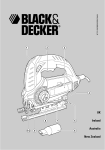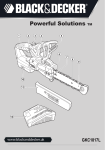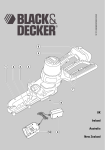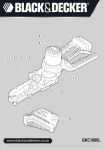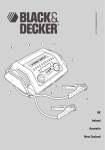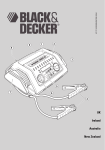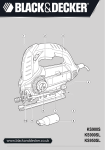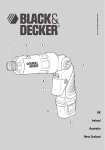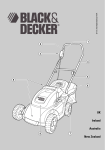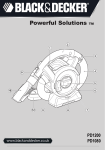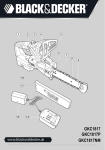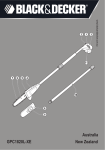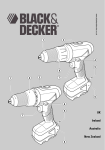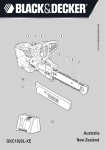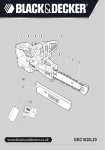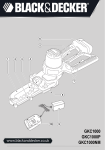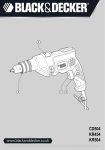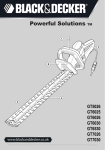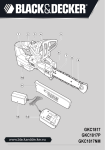Download Black & Decker GKC1817 Instruction manual
Transcript
UK Ireland Australia New Zealand 2 3 Intended use ENGLISH Your Black & Decker Compact Chainsaw has been designed for light duty cutting and pruning. This tool is intended for consumer use only. General safety rules Warning! Read all instructions. Failure to follow all instructions listed below may result in electric shock, fire and/or serious injury. The term "power tool" in all of the warnings listed below refers to your mains operated (corded) power tool or battery operated (cordless) power tool. SAVE THESE INSTRUCTIONS. 1. Work area a. Keep work area clean and well lit. Cluttered and dark areas invite accidents. b. Do not operate power tools in explosive atmospheres, such as in the presence of flammable liquids, gases or dust. Power tools create sparks which may ignite the dust or fumes. c. Keep children and bystanders away while operating a power tool. Distractions can cause you to lose control. 2. Electrical safety a. Power tool plugs must match the outlet. Never modify the plug in any way. Do not use any adapter plugs with earthed (grounded) power tools. Unmodified plugs and matching outlets will reduce risk of electric shock. b. Avoid body contact with earthed or grounded surfaces such as pipes, radiators, ranges and refrigerators. There is an increased risk of electric shock if your body is earthed or grounded. c. Do not expose power tools to rain or wet conditions. Water entering a power tool will increase the risk of electric shock. d. Do not abuse the cord. Never use the cord for carrying, pulling or unplugging the power tool. Keep cord away from heat, oil, sharp edges or moving parts. Damaged or entangled cords increase the risk of electric shock. e. When operating a power tool outdoors, use an extension cord suitable for outdoor use. Use of a cord suitable for outdoor use reduces the risk of electric shock. 3. Personal safety a. Stay alert, watch what you are doing and use common sense when operating a power tool. Do not use a power tool while you are tired or under the influence of drugs, alcohol or medication. A moment of inattention while operating power tools may result in serious personal injury. b. Use safety equipment. Always wear eye protection. Safety equipment such as dust mask, non-skid safety shoes, 4 c. d. e. f. g. hard hat, or hearing protection used for appropriate conditions will reduce personal injuries. Avoid accidental starting. Ensure the switch is in the off position before plugging in. Carrying power tools with your finger on the switch or plugging in power tools that have the switch on invites accidents. Remove any adjusting key or wrench before turning the power tool on. A wrench or a key left attached to a rotating part of the power tool may result in personal injury. Do not overreach. Keep proper footing and balance at all times. This enables better control of the power tool in unexpected situations. Dress properly. Do not wear loose clothing or jewellery. Keep your hair, clothing and gloves away from moving parts. Loose clothes, jewellery or long hair can be caught in moving parts. If devices are provided for the connection of dust extraction and collection facilities, ensure these are connected and properly used. Use of these devices can reduce dust related hazards 4. Power tool use and care a. Do not force the power tool. Use the correct power tool for your application. The correct power tool will do the job better and safer at the rate for which it was designed. b. Do not use the power tool if the switch does not turn it on and off. Any power tool that cannot be controlled with the switch is dangerous and must be repaired. c. Disconnect the plug from the power source before making any adjustments, changing accessories, or storing power tools. Such preventive safety measures reduce the risk of starting the power tool accidentally. d. Store idle power tools out of the reach of children and do not allow persons unfamiliar with the power tool or these instructions to operate the power tool. Power tools are dangerous in the hands of untrained users. e. Maintain power tools. Check for misalignment or binding of moving parts, breakage of parts and any other condition that may affect the power tools operation. If damaged, have the power tool repaired before use. Many accidents are caused by poorly maintained power tools. f. Keep cutting tools sharp and clean. Properly maintained cutting tools with sharp cutting edges are less likely to bind and are easier to control. g. Use the power tool, accessories and tool bits etc., in accordance with these instructions and in the manner intended for the particular type of power tool, taking into account the working conditions and the work to be performed. Use of the power tool for operations different from those intended could result in a hazardous situation. 5. Battery tool use and care a. Ensure the switch is in the off position before inserting battery pack. Inserting the battery pack into power tools that have the switch on invites accidents. b. Recharge only with the charger specified by the manufacturer. A charger that is suitable for one type of battery pack may create a risk of fire when used with another battery pack. c. Use power tools only with specifically designated battery packs. Use of any other battery packs may create a risk of injury and fire. d. When battery pack is not in use, keep it away from other metal objects like paper clips, coins, keys, nails, screws, or other small metal objects that can make a connection from one terminal to another. Shorting the battery terminals together may cause burns or a fire. e. Under abusive conditions, liquid may be ejected from the battery; avoid contact. If contact accidentally occurs, flush with water. If liquid contacts eyes, additionally seek medical help. Liquid ejected from the battery may cause irritation or burns. 6. Service a. Have your power tool serviced by a qualified repair person using only identical replacement parts. This will ensure that the safety of the power tool is maintained. Additional safety instructions for compact chainsaws The intended use is described in this instruction manual. Do not use the tool for purposes not intended; for example do not use the tool to fell trees. The use of any accessory or attachment or performance of any operation with this tool other than those recommended in this instruction manual may present a risk of personal injury. X Wear close fitting and protective clothing including a safety helmet with visor/goggles, ear protectors, non-skid safety footwear, protective bib trousers and strong leather gloves. X Always position yourself out of the path of falling branches. X The safe distance between a branch to be felled and bystanders, buildings and other objects is at least 2 1/2 times the length of the branch. Any bystander, building or object within this distance is at risk from being struck by the falling branch. X Pre-plan a safe exit from falling branches. Ensure the exit route is clear of obstacles that would prevent or hinder movement. Remember wet grass and freshly cut bark is slippery. X Ensure someone is nearby (but at a safe distance) in case of an accident. X Do not use the tool while standing in a tree, on a ladder or on any other unstable surface. X Keep proper footing and balance at all times. X X X X X X X X X X Hold the tool firmly with both hands when the motor is running. Do not let the moving chain contact any object at the tip of the guide bar. Start cutting only with the chain moving at full speed. Do not attempt to enter a previous cut. Always make a fresh cut. Watch for shifting branches or other forces that could close a cut and pinch or fall into the chain. Do not attempt to cut a branch when the diameter of the branch exceeds the cutting length of the tool. Always remove the battery from the tool and place the chain cover assembly over the chain when storing or transporting the tool. Keep the saw chain sharp and properly tensioned. Check the tension at regular intervals. Switch the tool off, allow the chain to stop and remove the battery from the tool before carrying out any adjustment, servicing or maintenance. Only use genuine replacement parts and accessories. Causes and operator prevention of kickback Kickback may occur when the nose or tip of the guide bar touches an object, or when the wood closes in and pinches the saw chain in the cut. Tip contact in some cases may cause a sudden reverse reaction, kicking the guide bar up and back towards the operator. Pinching the saw chain along the top of the guide bar may push the guide bar rapidly back towards the operator. Either of these reactions may cause you to lose control of the chainsaw which could result in serious personal injury. Do not rely exclusively upon the safety devices built into your chainsaw. As a chainsaw user, you should take several steps to keep your cutting jobs free from accident or injury. Kickback is the result of tool misuse and / or incorrect operating procedures or conditions and can be avoided by taking proper precautions as given below: X Maintain a firm grip, with thumbs and fingers encircling the chainsaw handles. With both hands on the chainsaw, position your body and arm to allow you to resist kickback forces. Kickback forces can be controlled by the operator, if proper precautions are taken. Do not let go of the chainsaw. X Do not overreach and do not cut above shoulder height. This helps prevent unintended tip contact and enables better control of the chainsaw in unexpected situations. X Only use replacement guide bars and chains specified by the manufacturer. Incorrect replacement guide bars and chains may cause chain breakage and/or kickback. 5 Follow the manufacturer's sharpening and maintenance instructions for the saw chain. Decreasing the depth gauge height can lead to increased kickback. X Safety recommendations for the chainsaw X We strongly recommend that first time users obtain practical instruction in the use of the chainsaw and protective equipment from an experienced user. Initial practice should be completed sawing logs on a saw horse or cradle. X We recommend that when carrying the chainsaw that you make sure that the brake is engaged X Maintain your chainsaw when not in use. Do not store your chainsaw for any length of time without first removing the saw chain and guide bar which should be kept immersed in oil. Store all parts of your chainsaw in a dry, secure place out of reach of children. X We recommend you drain the oil reservoir prior to storage. X Be sure of your footing and pre-plan a safe exit from a falling tree or branches. X Use wedges to help control felling and prevent binding the guide bar and saw chain in the cut. X Saw chain care. Keep the saw chain sharp and snug on the guide bar. Ensure the saw chain and guide bar are clean and well oiled. Keep handles dry, clean and free from oil and grease. Kickback can be caused by: X Striking branches or other objects accidentally with a tip of the saw while the saw chain is moving. X Striking metal, cement or any other hard material near the wood, or buried in the wood. X A dull or loose chain. X Cutting above shoulder height. X Lack of attention when holding or guiding the chainsaw while cutting. X Over-reaching. Keep proper footing and balance at all times and do not overreach. X Do not try to insert into a previous cut. As this could cause kickback. Make a fresh cut every time. X We strongly recommend you do not attempt to operate your chainsaw while in a tree, on a ladder or on any other unstable surface. If you decide to do so, be advised that these positions are extremely dangerous. X When cutting a branch that is under tension, be alert for spring back so that you will not be struck when the tension is released. Avoid cutting: Prepared timber. X Into the ground. X Into wire fences, nails. etc. X 6 X X X X X X Into small sized brush and saplings because slender material may catch the saw chain and be whipped towards you, or pull you off balance. Do not use your chainsaw above shoulder height. Ensure someone is nearby (but at a safe distance) in case of an accident. If for any reason you have to touch the saw chain, make sure your chainsaw is disconnected from the mains. The noise from this product can exceed 85 dB(A). We therefore recommend you take appropriate measures for the protection of hearing. Warning symbols The following warning symbols are found on your tool: Read all of this manual carefully. Do not use your saw in wet conditions or expose it to rain. Always wear head, ear and eye protection. Always wear non-slip safety footwear. Beware of falling objects. keep bystanders away. To ensure continued safe operation, check the chain tension as described in this manual after every 10 minutes of use, and adjust back to a clearance of 3 mm as required. Oil the chain after every 10 minutes of use. Direction of rotation of the chain. To ensure continued safe operation, the chain and guide bar must only be replaced with original Black & Decker parts. Replacement chain part number A6158 replacement guide bar part number 90517720. Additional safety instructions for batteries and chargers Batteries Never attempt to open for any reason. X Do not expose the battery to water. X Do not store in locations where the temperature may exceed 40 °C. X Charge only at ambient temperatures between 4 °C and 40 °C. X Charge only using the charger provided with the tool. X When disposing of batteries, follow the instructions given in the section “Protecting the environment”. X Under extreme conditions, battery leakage may occur. When you notice liquid on the battery, proceed as follows: - Carefully wipe the liquid off using a cloth. Avoid skin contact. - In case of skin or eye contact, follow the instructions below. Warning! The battery fluid, a 25-30% solution of potassium hydroxide, can be harmful. In case of skin contact, immediately rinse with water. Neutralise with a mild acid such as lemon juice or vinegar. In case of eye contact, rinse abundantly with clean water for at least 10 minutes. Consult a physician. X Do not incinerate the battery. X Do not attempt to charge damaged batteries. Features 1. On/off switch 2. Lock-off button 3. Oil cap 4. Oil reservoir 5. Front guard assembly 6. Chain cover assembly 7. Chain tension adjustment screw 8. Chain 9. Guide bar 10. Battery 11. Chain sheath 12. Charger receptacle 13. Charger Chargers X Use your Black & Decker charger only to charge the battery in the tool with which it was supplied. Other batteries could burst, causing personal injury and damage. X Never attempt to charge non-rechargeable batteries. X Have defective cords replaced immediately. X Do not expose the charger to water. X Do not open the charger. X Do not probe the charger. Warning! Before assembly, remove the battery (10) from the tool. X The following symbols are found on your charger: Fail-safe isolating transformer. The mains supply is electrically separated from the transformer output. The charger automatically shuts off if the ambient temperature becomes too high. As a consequence the charger will be inoperable. The charging base must be disconnected from the mains supply and taken to an authorised service centre for repair. The charger is intended for indoor use only. Electrical safety Your charger is double insulated; therefore no earth wire is required. Always check that the power supply corresponds to the voltage on the rating plate. Warning! Never attempt to replace the charger unit with a regular mains plug. X If the supply cord is damaged, it must be replaced by the manufacturer or an authorised Black & Decker Service Centre in order to avoid a hazard. Assembly Fitting and removing the battery (fig. A) X To fit the battery (10), line it up with the receptacle on the tool. Slide the battery (10) into the receptacle and push until the battery (10) snaps into place. X To remove the battery (10), push the release button (24) while at the same time pulling the battery (10) out of the receptacle. Warning! To prevent accidental operation, make sure that the battery is removed and that the chain sheath (11) is in place on the saw chain (8) before performing the following operations. Failure to do this could result in serious personal injury. Charging the battery (fig. B and C) The battery (10) needs to be charged before first use and whenever it fails to produce sufficient power on jobs that were easily done before. When charging the battery (10) for the first time, or after prolonged storage, it will only accept an 80% charge. After several charge and discharge cycles, the battery (10) will attain full capacity. The battery (10) may become warm while charging; this is normal and does not indicate a problem. Warning! Do not charge the battery at ambient temperatures below 4 °C or above 40 °C. Recommended charging temperature: approx. 24 °C. 8 hour charger (fig. B) X To charge the battery (10), remove it from the tool and slide the charger receptacle (12) onto the battery (10). X Plug in the charger (13). The battery (10) will be fully charged in approximately 8 hours. It can be removed at any time or left in the connected charger indefinitely. 7 1 hour charger (fig. C) X To charge the battery (10), remove it from the tool and insert it into the charger (23). The battery (10) will only fit into the charger (23) in one way. Do not force. Be sure that the battery (10) is fully seated in the charger (23). X Plug in the charger (23). X Check that the red charging indicator comes on. If the green ‘end of charge’ indicator comes on then the battery is too hot and cannot be charged. If this happens, remove the battery (10) from the charger (23), let the battery cool down for approximately 1 hour and re-insert it. After approximately 1 hour of charging, the red charging indicator will go off and the green ‘end of charge’ indicator will come on. The battery is now fully charged. X Remove the battery (10) from the charger (23). Installing and removing the saw chain (fig. D - F & H) Always wear protective gloves when installing or removing the saw chain (8). The saw chain (8) is sharp and can cut you when it is not running. Place the tool on a firm and stable surface. Loosen the 2 Allen screws (14) using the Allen key (21) provided. Remove the Allen screws (14). Remove the chain cover assembly (6). Turn the chain tension adjustment screw (7) counter clockwise to allow the guide bar (9) to recede and to reduce the tension on the saw chain (8). Remove the old saw chain (8) from the sprocket (15) and the guide bar (9). Place the new saw chain (8) in the groove of the guide bar (9) and around the sprocket (15). Make sure that the teeth are facing the correct direction by matching the arrow on the saw chain (8) with the arrow on the chain cover assembly (6). Make sure that the slot (17) in the guide bar (9) is over the location pins (18) and that the hole (20) below the slot is located over the adjustment pin (19). Fit the chain cover assembly (6) and the 2 Allen screws (14). Tighten the Allen screws (14) using the Allen key (21) provided. Adjust the chain tension as described below. X X X X X X X X X X Checking and adjusting the chain tension (fig. D and G) X Check the saw chain tension. The tension is correct when the saw chain (8) snaps back after being pulled away 3 mm from the guide bar (9) with light force from the middle finger and thumb. There should be no ‘sag’ between the guide bar (9) and the saw chain (8) on the underside. 8 To adjust the tension: X Loosen the 2 Allen screws (14). X Turn the chain tension adjustment screw (7) clockwise. Warning! Do not over-tension the chain as this will lead to excessive wear and will reduce the life of the bar and chain. X Once the chain tension is correct, tighten the 2 Allen screws (14). Warning! When the saw chain is new, check the tension frequently during the first two hours of use as a new saw chain stretches slightly. Filling the oil reservoir (fig. H) X Remove the oil cap (3) and fill the reservoir (4) with the recommended chain oil. You can see the oil level in the oil reservoir (4). Refit the oil cap (3). X Periodically switch off and check the oil level; if it is less than a quarter full, remove the battery (10) from the tool and refill the reservoir (4) with the correct oil. Oiling the chain (fig. H) The saw chain (8) must be oiled before each use and after cleaning using only the correct grade of oil (cat. no. A6027). X Lubricate the saw chain (8) by pressing the bulb on the oil cap (3) twice before making each cut, holding the bulb down for 3-4 seconds. Use Switching on and off (fig. H) For your safety, this tool is equipped with a double switching system. This system prevents starting the tool inadvertently. Switching on X Press the lock-off button (2) and at the same time squeeze the on/off switch (1). X Release the lock-off button (2). Switching off X Release the on/off switch (1). Warning! Never attempt to lock a switch in the on position. Pruning trees (fig. I) Make sure that there are no local by-laws or regulations that would prohibit or control the pruning of the tree limbs. Pruning should only be undertaken by experienced users there is an increased risk of the saw chain (8) pinching and kickback. Before pruning consideration should be given to conditions affecting the direction of fall including: X The length and weight of the branch to be cut. X Any unusual heavy limb structure or decay. X Surrounding trees and obstacles including overhead. X The wind speed and direction. X The branch being intertwined with other branches. The operator should consider access to the tree limb and the direction of fall. The tree branch is liable to swing towards the tree trunk. In addition to the user bystanders, objects and property below the branch will be at risk. To avoid splintering, the first cut is made in an upward direction to a maximum depth of one third the diameter of the branch. The second cut is made downwards to meet the first. Light duty cutting (fig. J) How you should cut depends on how the log is supported. Use a saw horse whenever possible. Always start a cut with the saw chain (8) running and the spiked bumper in contact with the wood. To complete the cut, use a pivoting action of the spiked bumper against the wood. When supported along its whole length: X Make a downward cut, but avoid cutting the earth as this will blunt your saw chain quickly. When supported at both ends: First, cut one third down to avoid splintering and second, cut again to meet the first cut, X When supported at one end: X First cut one third up to avoid splintering and second, cut down to prevent splintering. When on a slope: Always stand on the uphill side. To clean the tool, use only mild soap and a damp cloth. Never let any liquid get inside the tool and never immerse any part of the tool into liquid. X Remove debris using a hard brush. X Lubricate the chain (8) with oil. Saw chain sharpening If you are to get the best possible performance from the tool it is important to keep the teeth of the saw chain sharp. Guidance for this procedure is found on the sharpener package. For this purpose we recommend the purchase of the Black & Decker saw chain sharpening kit, available from your Black & Decker service agents (cat. no. A6039). Replacing worn out or damaged saw chains and guide bars Replacement saw chains are available through retailers and Black & Decker service agents( pt no A6158), replacement guide bars are only available through Black & Decker service agents (pt no 90517720). To avoid the risk of injury, use only original Black & Decker chains and guide bars. Always use genuine spare parts. Saw chain sharpness The saw chain cutters will blunt immediately if they touch the ground or a nail whilst cutting. X Saw chain tension When using a saw horse (fig. J): Regularly check the saw chain tension. This is strongly recommended whenever possible. X Position the log in a stable position. Always cut on the outside of the saw horse arms. Use clamps or straps to secure the workpiece. Cleaning, maintenance and storage Your Black & Decker tool has been designed to operate over a long period of time with a minimum of maintenance. What to do if your chainsaw needs repair. Your tool is in accordance with the relevant safety requirements. Repairs should only be carried out by a qualified person using original spare parts otherwise this may result in considerable danger to the user. We recommend you keep this user manual in a safe place. Storage Continuous satisfactory operation depends upon proper tool care and regular cleaning. When the tool will not be used for several months, ideally leave the battery (10) connected to the charger. Your charger does not require any maintenance apart from regular cleaning. Warning! Before performing any maintenance on the tool, remove the battery from the tool. Unplug the charger before cleaning it. Otherwise proceed as follows: X Remove the battery (10) from the tool. X Fully charge the battery (10). X Store the tool and battery (10) in a secure and dry location. The storage temperature must always remain in the range of +5 °C to +40 °C. Place the battery (10) on a level surface. X Before using the tool after prolonged storage, fully charge the battery (10) again. Fitting the battery cap (fig. K) Warning! Fit the cap (22) to the battery (10) for transportation and storage. After use and before storage Regularly clean the ventilation slots with a clean, dry paint brush. 9 Protecting the environment Separate collection. This product must not be disposed of with normal household waste. Should you find one day that your tool needs replacement, or if it is of no further use to you, think of the protection of the environment. Black & Decker repair agents will accept old Black & Decker tools and ensure that they are disposed of in an environmentally safe way. Separate collection of used products and packaging allows materials to be recycled and used again. Re-use of recycled materials helps prevent environmental pollution and reduces the demand for raw materials. Local regulations may provide for separate collection of electrical products from the household, at municipal waste sites or by the retailer when you purchase a new product. Black & Decker provides a facility for the collection and recycling of Black & Decker products once they have reached the end of their working life. To take advantage of this service please return your product to any authorised repair agent who will collect them on our behalf. You can check the location of your nearest authorised repair agent by contacting your local Black & Decker office at the address indicated in this manual. Alternatively, a list of authorised Black & Decker repair agents and full details of our after-sales service and contacts are available on the Internet at: www.2helpU.com. Batteries Black & Decker batteries can be recharged many times. At the end of their useful life, discard batteries with due care for our environment: Run the battery down completely, then remove it from the tool. NiCd and NiMH batteries are recyclable. Take them to any authorised repair agent or a local recycling station. X X 10 Technical data X Voltage Vdc No load chain speed min-1 Weight kg GKC1817 18 190 2 GKC1817NM 18 190 2 X X X Battery Voltage Capacity Weight Vdc Ah kg Charger Voltage Approx charging time 18 18 1.7-1.5 NiCd 1.5 NiMH 0.8 0.8 Vac h 8 hr 230 8 1 hr 230 1 EC declaration of conformity GKC1817/GKC1817NM Black & Decker declares that these products conform to: 98/37/EC, 89/336/EEC, 2006/95/EC, 2002/96/EC, 2002/95/EC, EN 55014, EN 61000, EN 60745, 2000/14/EC. Level of sound pressure measured according to 2000/14/EC: LpA (sound pressure) 78.6dB(A) LWA (acoustic power) 89.6 dB(A) LWA (guaranteed) 90 dB(A) Always wear ear protection if the sound pressure exceeds 85 dB (A). Hand/arm weighted vibration value according to EN60745: 4 m/sec2 The product has been used for trade, professional or hire purposes. The product has been subjected to misuse or neglect. The product has sustained damage through foreign objects, substances or accidents. Repairs have been attempted by persons other than authorised repair agents or Black & Decker service staff. To claim on the guarantee, you will need to submit proof of purchase to the seller or an authorised repair agent. You can check the location of your nearest authorised repair agent by contacting your local Black & Decker office at the address indicated in this manual. Alternatively, a list of authorised Black & Decker repair agents and full details of our aftersales service and contacts are available on the Internet at: www.2helpU.com Please visit our website www.blackanddecker.co.uk to register your new Black & Decker product and to be kept up to date on new products and special offers. Further information on the Black & Decker brand and our range of products is available at www.blackanddecker.co.uk. Kevin Hewitt Director of Consumer Engineering Spennymoor, County Durham DL16 6JG, United Kingdom 30-05-2007 Guarantee Black & Decker is confident of the quality of its products and offers an outstanding guarantee. This guarantee statement is in addition to and in no way prejudices your statutory rights. The guarantee is valid within the territories of the Member States of the European Union and the European Free Trade Area. If a Black & Decker product becomes defective due to faulty materials, workmanship or lack of conformity, within 24 months from the date of purchase, Black & Decker guarantees to replace defective parts, repair products subjected to fair wear and tear or replace such products to ensure minimum inconvenience to the customer unless: 11 12 13 14 15 $XVWUDOLD %ODFN'HFNHU$XVWUDOLD3W\/WG )OHWFKHU5RDG0RRURROEDUN 9LFWRULD 1HZ=HDODQG %ODFN'HFNHU 7H$SXQJD3ODFH 0W:HOOLQJWRQ $XFNODQG 8QLWHG.LQJGRP %ODFN'HFNHU %DWK5RDG 6ORXJK%HUNVKLUH6/<' 90521967 7HO )D[ 7HO )D[ 7HO )D[ +HOSOLQH 06/07
















